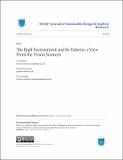Files in this item
The built environment and its patterns : a view from the vision sciences
Item metadata
| dc.contributor.author | Wilkins, Arnold J. | |
| dc.contributor.author | Penacchio, Olivier | |
| dc.contributor.author | Leonards, Ute | |
| dc.date.accessioned | 2018-11-22T15:30:09Z | |
| dc.date.available | 2018-11-22T15:30:09Z | |
| dc.date.issued | 2018-11-22 | |
| dc.identifier | 256520265 | |
| dc.identifier | 9171ac88-2573-44c3-9f25-346458834aea | |
| dc.identifier.citation | Wilkins , A J , Penacchio , O & Leonards , U 2018 , ' The built environment and its patterns : a view from the vision sciences ' , Journal of Sustainable Design and Applied Research in Innovative Engineering of the Built Environment , vol. 6 , no. 1 , 5 . < https://arrow.dit.ie/sdar/vol6/iss1/5/ > | en |
| dc.identifier.issn | 2009-549X | |
| dc.identifier.uri | https://hdl.handle.net/10023/16525 | |
| dc.description.abstract | Visual patterns are all around us. Despite overwhelming evidence from the visual sciences that some visual patterns, in particular highly-geometric and repetitive patterns, can be aversive, patterns in our visual environment are rarely considered with regard to their impact on brain, behaviour and well-being. Yet, attempts toward developing healthier, more inclusive cities recently attracted negative headlines, for example for their use of dazzling floor patterns in public spaces that lead to discomfort, avoidance behaviours and falls, particularly in older citizens. Recent developments in analysis now allow us to measure and predict adverse effects of patterns in the real world. Here, we show that aversive patterns are rare in natural scenes but prevalent in modern man-made settings. They occur at every spatial scale, partly because of modular construction, partly because of artistic expression. We review the evidence that visual discomfort and other adverse neurological and behavioural effects arise from aversive patterns, and hypothesise that this is because of the way our visual system has evolved to analyse scenes from nature. We finish our review with an outlook for future research and by proposing some simple ways of preventing adverse effects from visual environments, using urban design as example. | |
| dc.format.extent | 7 | |
| dc.format.extent | 449327 | |
| dc.language.iso | eng | |
| dc.relation.ispartof | Journal of Sustainable Design and Applied Research in Innovative Engineering of the Built Environment | en |
| dc.subject | Visual patterns | en |
| dc.subject | Visual discomfort | en |
| dc.subject | Migraine | en |
| dc.subject | Urban environment | en |
| dc.subject | Architecture | en |
| dc.subject | BF Psychology | en |
| dc.subject | NDAS | en |
| dc.subject.lcc | BF | en |
| dc.title | The built environment and its patterns : a view from the vision sciences | en |
| dc.type | Journal article | en |
| dc.contributor.institution | University of St Andrews. School of Psychology and Neuroscience | en |
| dc.description.status | Peer reviewed | en |
| dc.identifier.url | https://research-information.bris.ac.uk/explore/en/publications/the-built-environment-and-its-patterns-a-view-from-the-vision-sciences(49945639-e516-4e38-82e8-295ecae4fa27).html?_ga=2.86653784.1131004554.1541756171-518417697.1511262793 | en |
| dc.identifier.url | https://arrow.dit.ie/sdar/vol6/iss1/5/ | en |
This item appears in the following Collection(s)
Items in the St Andrews Research Repository are protected by copyright, with all rights reserved, unless otherwise indicated.

